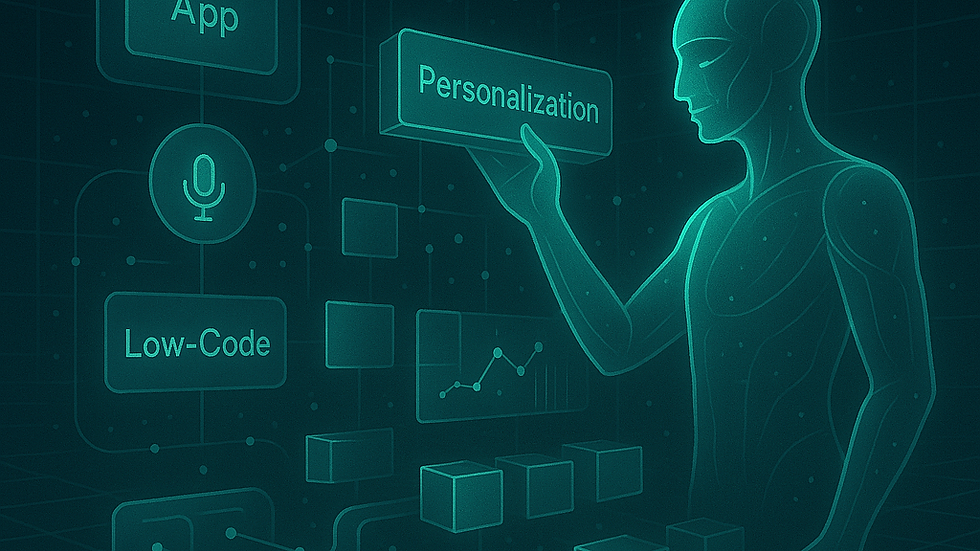New Web Architecture :: The Future of Websites in the Age of AI [Part 2]
- Nimrod Bahar

- Aug 30
- 3 min read
Updated: Oct 7

| The Future of Websites: From Hand-Coded Pages to AI Co-Creation
Not long ago, building a website meant long hours of manual coding, debugging, and deploying line by line. A small mistake could break a page. Launching even a basic e-commerce site took weeks. Fast forward to today: developers can type a plain-English request, and an AI copilot generates the code. Low-code platforms let non-engineers drag and drop their way to a live application. Websites are no longer just written - they’re co-created with AI.
Key Points We Will Discuss:
AI in Development – Generative AI coding boosts productivity by 35–45%.
Low-Code/No-Code Explosion – 70% of enterprise apps will be built with low-code by 2025.
Personalization Engines – 71% of users are frustrated by impersonal experiences.
Progressive Web Apps (PWAs) – The market is growing at a 32% CAGR.
Takeaway – Web architecture is shifting to AI-assisted, low-code, app-like, and hyper-personalized experiences.
| AI as the New Development Partner
Generative AI is transforming how websites are built:
Coding is now 35–45% faster with AI copilots, according to McKinsey.
By 2030, 20–45% of software engineering output may be automated.
Junior developers benefit from “instant mentorship,” as AI explains and optimizes code in real time.
Rather than replacing developers, AI enhances their capabilities.
It automates routine tasks like boilerplate coding, testing, and documentation, allowing humans to focus on architecture, strategy, and creativity.
| The Rise of Low-Code and No-Code
A new class of builders is on the rise: “citizen developers.” With platforms like Wix Studio, Webflow, and Bubble, anyone can now build functional websites without writing a single line of code.
According to Gartner, by 2025, 70% of new enterprise applications will be created using low-code or no-code tools. The market is set to reach $187 billion by 2030, thanks to development speeds 50–90% faster than traditional methods.
This shift empowers business teams to build solutions on demand, rather than waiting on IT. The outcome is more experimentation, faster innovation, and a surge in new websites.
| Personalization Becomes the Default
Static websites are disappearing.
Today’s user expects a site to “know” them.
71% of users are frustrated by impersonal experiences.
AI-driven personalization can boost revenue by 5–15% and enhance marketing ROI by 10–30%.
From product recommendations to dynamic page layouts, personalization engines turn one website into millions of micro-experiences. Every visitor sees a different version tailored to their intent, context, and behavior.
| Progressive Web Apps: Blurring the Line Between Web and App
Websites are also becoming more app-like through Progressive Web Apps (PWAs).
The PWA market is growing at 32% CAGR.
Case study: MakeMyTrip’s PWA delivered a 3× increase in conversion rate and 160% more sessions.
Building a PWA is 3–8× cheaper than building a native mobile app.
PWAs load instantly, work offline, and send push notifications. For users, the distinction between “website” and “app” is fading.
| So, What This Means for Businesses
The new web architecture is built on speed, scale, and intelligence. Businesses that want to stay relevant must:
Adopt AI in Development – Leverage copilots to cut costs and accelerate launches.
Experiment with Low-Code – Empower non-technical teams while keeping governance.
Invest in Personalization – Treat every visitor as a unique audience of one.
Go App-Like – Consider PWAs to deliver faster, more engaging experiences.
| Embracing Change in the Digital Landscape
The way websites are built is being reinvented. AI copilots, low-code platforms, and app-like experiences are no longer experiments. They’re becoming the standard.
If you want to keep learning how to future-proof your site in the age of AI, follow along with my blog series, The Future of Websites in the Age of AI.
👉 Sign up now and get each article delivered as soon as it’s published. The next chapter explores how SEO is evolving into GEO, Generative Engine Optimization, and what that means for your online visibility.
| Final Thoughts on the Future of Websites
The architecture of the web has always changed with technology. HTML gave way to CMS, CMS to mobile-first, and now mobile-first to AI-first. By 2030, the majority of websites will be AI-assisted, low-code, personalized, and app-like.
The question isn’t whether your site will adapt—it’s whether you’ll be one of the businesses leading the change or scrambling to catch up.

—
👉 Created by Nimrod Bahar, CEO, powered by "Digital Craftr" AI
Founder of NimblePRO, Digital Transformation & AI Explorer
Helping businesses master AI, automation, and scalable websites.
contact@nimble-pro.com | 📩 Have a challenge? *Book now





Comments